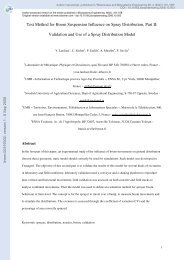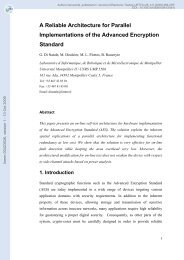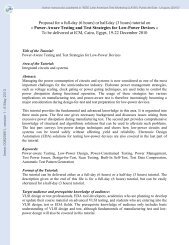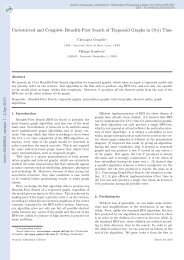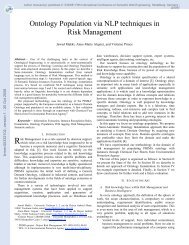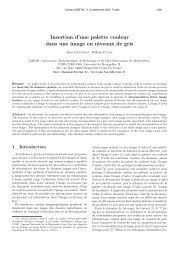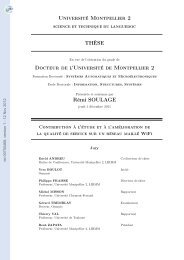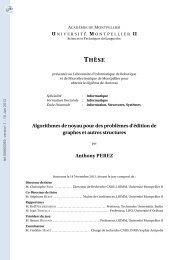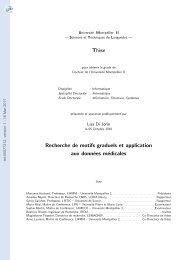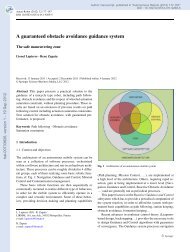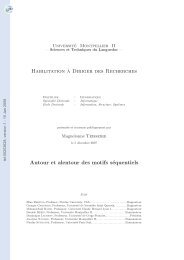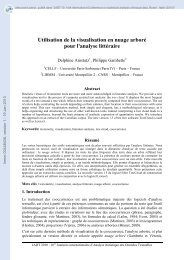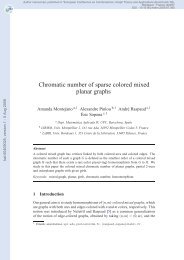FMA & HMTP Portal in OWL - HAL - LIRMM - CNRS
FMA & HMTP Portal in OWL - HAL - LIRMM - CNRS
FMA & HMTP Portal in OWL - HAL - LIRMM - CNRS
You also want an ePaper? Increase the reach of your titles
YUMPU automatically turns print PDFs into web optimized ePapers that Google loves.
templates is possible. Enhanced annotations are used for the metadata attached to the<br />
<strong>FMA</strong> entities. While <strong>OWL</strong> 1 allowed extralogical annotations, such as a label or a<br />
comment, <strong>OWL</strong> 2 additionally allows for annotations of axioms and of annotations<br />
themselves. In <strong>FMA</strong> frames, properties such as preferred name, synonyms, non-<br />
English equivalents, etc. are modeled by slots assigned with <strong>in</strong>dividuals of the<br />
Concept name class as values. As they concern metadata and not data the doma<strong>in</strong> of<br />
anatomy, us<strong>in</strong>g <strong>OWL</strong> 2 annotations of annotation is more appropriate: the doma<strong>in</strong> and<br />
meta-level data are no more confused and do not <strong>in</strong>teract. Besides, a huge number of<br />
<strong>in</strong>dividuals are thus removed. For example, the class Heart (1) is annotated by the<br />
label "Coeur"@fr (4), the label<strong>in</strong>g itself be<strong>in</strong>g annotated (2) by its creator JOSE<br />
MEJINO MD (2), date (3), <strong>FMA</strong>ID "217079" (4), publisher, etc.<br />
(1) Declaration(Class(:Heart))<br />
(2) AnnotationAssertion(Annotation(dc:creator "JOSE MEJINO MD"^^xsd:str<strong>in</strong>g)<br />
(3) Annotation(dc:date "Thu May 12 142434 GMT-0800 2005"^^xsd:date)<br />
(4) Annotation(:<strong>FMA</strong>ID "217079"^^xsd:str<strong>in</strong>g)... rdfs:label :Heart "Coeur"@fr)<br />
2.2 Formalization <strong>in</strong> <strong>OWL</strong><br />
Another ma<strong>in</strong> challenge is to enrich the <strong>FMA</strong> with formal def<strong>in</strong>itions and axioms<br />
hav<strong>in</strong>g a sound anatomical mean<strong>in</strong>g. The formalization process has two ma<strong>in</strong> steps.<br />
The first step formalizes the <strong>FMA</strong> frames syntax <strong>in</strong> <strong>OWL</strong>, the second step the <strong>FMA</strong><br />
semantics. While the first transformation closely mirrors the <strong>FMA</strong> native model, the<br />
latter pushes the logical formalization further, add<strong>in</strong>g new def<strong>in</strong>itions and axioms to<br />
express semantics which was not stated <strong>in</strong> frames. Partly for historical reasons (<strong>in</strong><br />
2005 <strong>OWL</strong> 2 did not exist), the first step transforms <strong>FMA</strong> from frames to an <strong>OWL</strong> 1<br />
DL ontology (<strong>FMA</strong>-<strong>OWL</strong> v1), the second step br<strong>in</strong>gs it to <strong>OWL</strong> 2 (<strong>FMA</strong>-<strong>OWL</strong> 2).<br />
Formaliz<strong>in</strong>g Frames Syntax <strong>in</strong> <strong>OWL</strong> 1. The transformation of the frames syntax<br />
<strong>in</strong> <strong>OWL</strong> relies on 2005 rules [4]. In short, Protégé classes and slots are converted <strong>in</strong>to<br />
<strong>OWL</strong> classes and properties, with the specified doma<strong>in</strong> and range. Slot characteristics<br />
(<strong>in</strong>verse, symmetric, functional) are translated us<strong>in</strong>g correspond<strong>in</strong>g <strong>OWL</strong> constructs.<br />
Values of own slots of classes are converted either <strong>in</strong>to <strong>OWL</strong> values of annotation<br />
properties or <strong>in</strong>to existential property restrictions. As said above, property restrictions<br />
def<strong>in</strong>ed at metaclasses or classes are respectively transformed <strong>in</strong>to universal or<br />
existential property restrictions and metaclass <strong>in</strong>stantiation is replaced by a subclass<br />
relation. However, as the earlier program did not scale up and was not robust, it has<br />
been much revised. The new implemented mapp<strong>in</strong>g of the syntax can now handle the<br />
entire <strong>FMA</strong> and overcome the changes of <strong>FMA</strong> successive updates.<br />
Formaliz<strong>in</strong>g <strong>FMA</strong> Semantics <strong>in</strong> <strong>OWL</strong> 2. The second step pushes the logical<br />
formalization forwards. The semantics of the <strong>FMA</strong> ontology is enriched <strong>in</strong> several<br />
ways: (a) classes def<strong>in</strong>itions are automatically generated from patterns; (b) meanwhile<br />
numerous related axioms are automatically created or moved (c) New properties<br />
characteristics are added; As described §2.1 (d) <strong>OWL</strong> annotations of annotation are<br />
used for metadata (e) <strong>OWL</strong> 2 metaclasses are created, but can be omitted on demand.<br />
5



